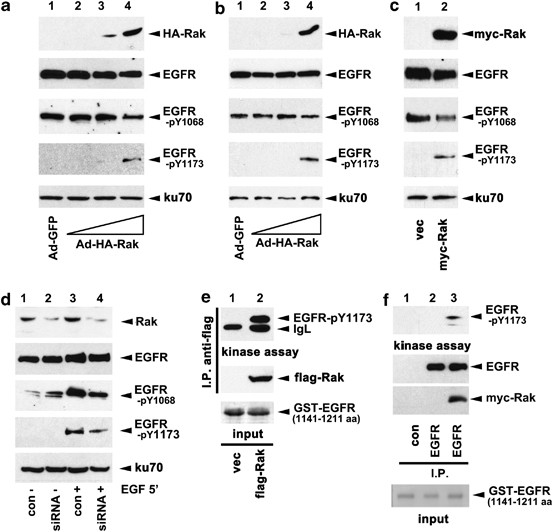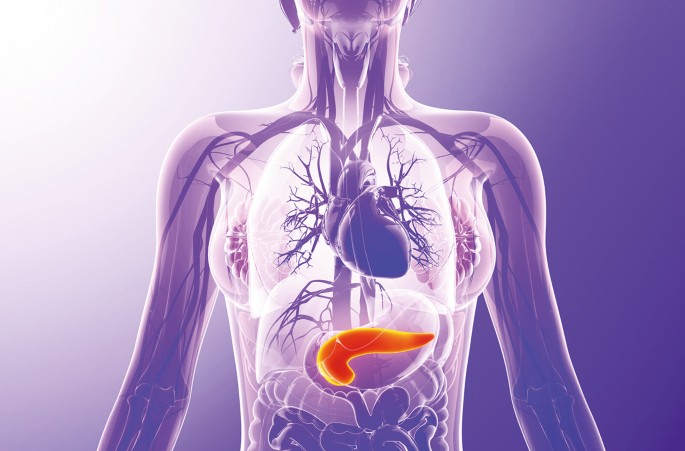
- Select a language for the TTS:
- UK English Female
- UK English Male
- US English Female
- US English Male
- Australian Female
- Australian Male
- Language selected: (auto detect) - EN
Play all audios:
ABSTRACT Src is the founding member of a diverse family of intracellular tyrosine kinases, and Src has a key role in promoting cancer growth, in part, through its association with receptor
tyrosine kinases. However, some Src-related proteins have widely divergent physiological roles, and these proteins include the Rak/Frk tyrosine kinase (Frk stands for _F_yn-_r_elated
_k_inase), which inhibits cancer cell growth and suppresses tumorigenesis. Rak/Frk phosphorylates and stabilizes the Pten tumor suppressor, protecting it from degradation, and Rak/Frk
associates with the retinoblastoma (Rb) tumor suppressor. However, the role of Rak/Frk in receptor-mediated signaling is largely unknown. Here, we demonstrate that Rak/Frk associates with
epidermal growth factor receptor (EGFR), increasing in activity and EGFR binding after EGF stimulation, when it decreases the pool of EGFR present at the plasma membrane. EGFR–Rak binding is
direct, requires the SH2 and SH3 domains of Rak/Frk for efficient complex formation and is not dependent on the Grb2 adaptor protein. EGFR mutations are associated with increased EGFR
activity and tumorigenicity, and we found that Rak/Frk associates preferentially with an EGFR exon 19 mutant, EGFRΔ747–749/A750P, compared with wild-type EGFR. Furthermore, Rak/Frk inhibited
mutant EGFR phosphorylation at an activating site and dramatically decreased the levels of EGFRΔ747–749/A750P from the plasma membrane. Taken together, the results suggest that Rak/Frk
inhibits EGFR signaling in cancer cells and has elevated activity against EGFR exon 19 mutants. Access through your institution Buy or subscribe This is a preview of subscription content,
access via your institution ACCESS OPTIONS Access through your institution Subscribe to this journal Receive 50 print issues and online access $259.00 per year only $5.18 per issue Learn
more Buy this article * Purchase on SpringerLink * Instant access to full article PDF Buy now Prices may be subject to local taxes which are calculated during checkout ADDITIONAL ACCESS
OPTIONS: * Log in * Learn about institutional subscriptions * Read our FAQs * Contact customer support SIMILAR CONTENT BEING VIEWED BY OTHERS EPS8 PHOSPHORYLATION BY SRC MODULATES ITS
ONCOGENIC FUNCTIONS Article Open access 09 July 2020 EGFR-DEPENDENT TYROSINE PHOSPHORYLATION OF INTEGRIN Β4 IS NOT REQUIRED FOR DOWNSTREAM SIGNALING EVENTS IN CANCER CELL LINES Article Open
access 21 April 2021 THE COMBINED ACTION OF THE INTRACELLULAR REGIONS REGULATES FGFR2 KINASE ACTIVITY Article Open access 14 July 2023 REFERENCES * Lemmon MA, Schlessinger J . Cell signaling
by receptor tyrosine kinases. _Cell_ 2010; 141: 1117–1134. Article CAS Google Scholar * Ganti AK . Epidermal growth factor receptor signaling in nonsmall cell lung cancer. _Cancer
Invest_ 2010; 28: 515–525. Article CAS Google Scholar * Sequist LV, Lynch TJ . EGFR tyrosine kinase inhibitors in lung cancer: an evolving story. _Annu Rev Med_ 2008; 59: 429–442. Article
CAS Google Scholar * Arteaga CL . ErbB-targeted therapeutic approaches in human cancer. _Exp Cell Res_ 2003; 284: 122–130. Article CAS Google Scholar * Rivera F, Vega-Villegas ME,
Lopez-Brea MF . Cetuximab, its clinical use and future perspectives. _Anticancer Drugs_ 2008; 19: 99–113. Article CAS Google Scholar * Paez JG, Janne PA, Lee JC, Tracy S, Greulich H,
Gabriel S _et al_. EGFR mutations in lung cancer: correlation with clinical response to gefitinib therapy. _Science_ 2004; 304: 1497–1500. Article CAS Google Scholar * Lynch TJ, Bell DW,
Sordella R, Gurubhagavatula S, Okimoto RA, Brannigan BW _et al_. Activating mutations in the epidermal growth factor receptor underlying responsiveness of non-small-cell lung cancer to
gefitinib. _N Engl J Med_ 2004; 350: 2129–2139. Article CAS Google Scholar * Gazdar AF . Activating and resistance mutations of EGFR in non-small-cell lung cancer: role in clinical
response to EGFR tyrosine kinase inhibitors. _Oncogene_ 2009; 28 (Suppl 1): S24–S31. Article CAS Google Scholar * Sorkin A, Goh LK . Endocytosis and intracellular trafficking of ErbBs.
_Exp Cell Res_ 2008; 314: 3093–3106. Article CAS Google Scholar * Keilhack H, Tenev T, Nyakatura E, Godovac-Zimmermann J, Nielsen L, Seedorf K _et al_. Phosphotyrosine 1173 mediates
binding of the protein-tyrosine phosphatase SHP-1 to the epidermal growth factor receptor and attenuation of receptor signaling. _J Biol Chem_ 1998; 273: 24839–24846. Article CAS Google
Scholar * Hsu JM, Chen CT, Chou CK, Kuo HP, Li LY, Lin CY _et al_. Crosstalk between Arg 1175 methylation and Tyr 1173 phosphorylation negatively modulates EGFR-mediated ERK activation.
_Nat Cell Biol_ 2011; 13: 174–181. Article CAS Google Scholar * Tanos B, Pendergast AM . Abl tyrosine kinase regulates endocytosis of the epidermal growth factor receptor. _J Biol Chem_
2006; 281: 32714–32723. Article CAS Google Scholar * Giubellino A, Burke TR, Bottaro DP . Grb2 signaling in cell motility and cancer. _Expert Opin Ther Targets_ 2008; 12: 1021–1033.
Article CAS Google Scholar * Lowenstein EJ, Daly RJ, Batzer AG, Li W, Margolis B, Lammers R _et al_. The SH2 and SH3 domain-containing protein GRB2 links receptor tyrosine kinases to ras
signaling. _Cell_ 1992; 70: 431–442. Article CAS Google Scholar * Smithgall TE . SH2 and SH3 domains: potential targets for anti-cancer drug design. _J Pharmacol Toxicol Methods_ 1995;
34: 125–132. Article CAS Google Scholar * Cance WG, Craven RJ, Weiner TM, Liu ET . Novel protein kinases expressed in human breast cancer. _Int J Cancer_ 1993; 54: 571–577. Article CAS
Google Scholar * Cance WG, Craven RJ, Bergman M, Xu L, Alitalo K, Liu ET . Rak, a novel nuclear tyrosine kinase expressed in epithelial cells. _Cell Growth Differ_ 1994; 5: 1347–1355. CAS
PubMed Google Scholar * Lee J, Wang Z, Luoh SM, Wood WI, Scadden DT . Cloning of FRK, a novel human intracellular SRC-like tyrosine kinase-encoding gene. _Gene_ 1994; 138: 247–251. Article
CAS Google Scholar * Serfas MS, Tyner AL . Brk, Srm, Frk, and Src42A form a distinct family of intracellular Src-like tyrosine kinases. _Oncol Res_ 2003; 13: 409–419. Article Google
Scholar * Boggon TJ, Eck MJ . Structure and regulation of Src family kinases. _Oncogene_ 2004; 23: 7918–7927. Article CAS Google Scholar * Craven RJ, Cance WG, Liu ET . The nuclear
tyrosine kinase Rak associates with the retinoblastoma protein pRb. _Cancer Res_ 1995; 55: 3969–3972. CAS PubMed Google Scholar * Meyer T, Xu L, Chang J, Liu ET, Craven RJ, Cance WG .
Breast cancer cell line proliferation blocked by the Src-related Rak tyrosine kinase. _Int J Cancer_ 2003; 104: 139–146. Article CAS Google Scholar * Yim EK, Peng G, Dai H, Hu R, Li K, Lu
Y _et al_. Rak functions as a tumor suppressor by regulating PTEN protein stability and function. _Cancer Cell_ 2009; 15: 304–314. Article CAS Google Scholar * Thuveson M, Albrecht D,
Zurcher G, Andres AC, Ziemiecki A . iyk, a novel intracellular protein tyrosine kinase differentially expressed in the mouse mammary gland and intestine. _Biochem Biophys Res Commun_ 1995;
209: 582–589. Article CAS Google Scholar * Berclaz G, Altermatt HJ, Rohrbach V, Dreher E, Ziemiecki A, Andres AC . Hormone-dependent nuclear localization of the tyrosine kinase iyk in the
normal human breast epithelium and loss of expression during carcinogenesis. _Int J Cancer_ 2000; 85: 889–894. Article CAS Google Scholar * Oberg-Welsh C, Anneren C, Welsh M . Mutation
of C-terminal tyrosine residues Y497/Y504 of the Src-family member Bsk/Iyk decreases NIH3T3 cell proliferation. _Growth Factors_ 1998; 16: 111–124. Article CAS Google Scholar *
Chandrasekharan S, Qiu TH, Alkharouf N, Brantley K, Mitchell JB, Liu ET . Characterization of mice deficient in the Src family nonreceptor tyrosine kinase Frk/rak. _Mol Cell Biol_ 2002; 22:
5235–5247. Article CAS Google Scholar * Georgescu MM . PTEN tumor suppressor network in PI3K-Akt pathway control. _Genes Cancer_ 2010; 1: 1170–1177. Article CAS Google Scholar * Emlet
DR, Moscatello DK, Ludlow LB, Wong AJ . Subsets of epidermal growth factor receptors during activation and endocytosis. _J Biol Chem_ 1997; 272: 4079–4086. Article CAS Google Scholar *
Katso RM, Pardo OE, Palamidessi A, Franz CM, Marinov M, De Laurentiis A _et al_. Phosphoinositide 3-kinase C2beta regulates cytoskeletal organization and cell migration via Rac-dependent
mechanisms. _Mol Biol Cell_ 2006; 17: 3729–3744. Article CAS Google Scholar * Jin G, Jeon HS, Yang E, Park JY . Mutation analysis of the FRK gene in non-small cell lung cancers. _Lung
Cancer_ 2011; 71: 115–117. Article Google Scholar * Goeze A, Schluns K, Wolf G, Thasler Z, Petersen S, Petersen I . Chromosomal imbalances of primary and metastatic lung adenocarcinomas.
_J Pathol_ 2002; 196: 8–16. Article Google Scholar * Brauer PM, Tyner AL . Building a better understanding of the intracellular tyrosine kinase PTK6—BRK by BRK. _Biochim Biophys Acta_
2010; 1806: 66–73. CAS PubMed PubMed Central Google Scholar * Haegebarth A, Bie W, Yang R, Crawford SE, Vasioukhin V, Fuchs E _et al_. Protein tyrosine kinase 6 negatively regulates
growth and promotes enterocyte differentiation in the small intestine. _Mol Cell Biol_ 2006; 26: 4949–4957. Article CAS Google Scholar * Zheng Y, Asara JM, Tyner AL . Protein-tyrosine
kinase 6 promotes peripheral adhesion complex formation and cell migration by phosphorylating p130 CRK-associated substrate. _J Biol Chem_ 2012; 287: 148–158. Article CAS Google Scholar *
Palka-Hamblin HL, Gierut JJ, Bie W, Brauer PM, Zheng Y, Asara JM _et al_. Identification of beta-catenin as a target of the intracellular tyrosine kinase PTK6. _J Cell Sci_ 2010; 123 (Part
2): 236–245. Article CAS Google Scholar * Zheng Y, Peng M, Wang Z, Asara JM, Tyner AL . Protein tyrosine kinase 6 directly phosphorylates AKT and promotes AKT activation in response to
epidermal growth factor. _Mol Cell Biol_ 2010; 30: 4280–4292. Article CAS Google Scholar * Li X, Lu Y, Liang K, Hsu JM, Albarracin C, Mills GB _et al_. Brk/PTK6 sustains activated EGFR
signaling through inhibiting EGFR degradation and transactivating EGFR. _Oncogene_ 2012; 31: 4372–4383. Article CAS Google Scholar * Kuriyan J, Cowburn D . Modular peptide recognition
domains in eukaryotic signaling. _Annu Rev Biophys Biomol Struct_ 1997; 26: 259–288. Article CAS Google Scholar * Buday L, Downward J . Epidermal growth factor regulates p21ras through
the formation of a complex of receptor, Grb2 adapter protein, and Sos nucleotide exchange factor. _Cell_ 1993; 73: 611–620. Article CAS Google Scholar * Okutani T, Okabayashi Y, Kido Y,
Sugimoto Y, Sakaguchi K, Matuoka K _et al_. Grb2/Ash binds directly to tyrosines 1068 and 1086 and indirectly to tyrosine 1148 of activated human epidermal growth factor receptors in intact
cells. _J Biol Chem_ 1994; 269: 31310–31314. CAS PubMed Google Scholar * Greulich H, Chen TH, Feng W, Janne PA, Alvarez JV, Zappaterra M _et al_. Oncogenic transformation by
inhibitor-sensitive and -resistant EGFR mutants. _PLoS Med_ 2005; 2: e313. Article Google Scholar * Furukawa M, Nagatomo I, Kumagai T, Yamadori T, Takahashi R, Yoshimura M _et al_.
Gefitinib-sensitive EGFR lacking residues 746–750 exhibits hypophosphorylation at tyrosine residue 1045, hypoubiquitination, and impaired endocytosis. _DNA Cell Biol_ 2007; 26: 178–185.
Article CAS Google Scholar * Padron D, Sato M, Shay JW, Gazdar AF, Minna JD, Roth MG . Epidermal growth factor receptors with tyrosine kinase domain mutations exhibit reduced Cbl
association, poor ubiquitylation, and down-regulation but are efficiently internalized. _Cancer Res_ 2007; 67: 7695–7702. Article CAS Google Scholar * Crudden G, Loesel R, Craven RJ .
Overexpression of the cytochrome p450 activator hpr6 (heme-1 domain protein/human progesterone receptor) in tumors. _Tumor Biol_ 2005; 26: 142–146. Article CAS Google Scholar Download
references ACKNOWLEDGEMENTS This work was supported by the Kentucky Lung Cancer Research Program, cycle 9. We thank Drs Gengxian Shi and Doug Andres for advice and reagents, Mary Gail Engle
of the University of Kentucky Imaging Core Facility for expertise in microscopy and Woodrow Friend for reading of the manuscript. AUTHOR INFORMATION AUTHORS AND AFFILIATIONS * Department of
Molecular and Biomedical Pharmacology, Markey Cancer Center, University of Kentucky, Lexington, KY, USA L Jin & R J Craven Authors * L Jin View author publications You can also search
for this author inPubMed Google Scholar * R J Craven View author publications You can also search for this author inPubMed Google Scholar CORRESPONDING AUTHOR Correspondence to R J Craven.
ETHICS DECLARATIONS COMPETING INTERESTS The authors declare no conflict of interest. ADDITIONAL INFORMATION Supplementary Information accompanies the paper on the Oncogene website
SUPPLEMENTARY INFORMATION SUPPLEMENTARY FIGURE 1 (JPG 127 KB) SUPPLEMENTARY FIGURE 2 (JPG 202 KB) SUPPLEMENTARY FIGURE 3 (JPG 260 KB) SUPPLEMENTARY FIGURE 4 (JPG 108 KB) SUPPLEMENTARY FIGURE
5 (JPG 231 KB) SUPPLEMENTARY FIGURE LEGENDS (DOC 33 KB) RIGHTS AND PERMISSIONS Reprints and permissions ABOUT THIS ARTICLE CITE THIS ARTICLE Jin, L., Craven, R. The Rak/Frk tyrosine kinase
associates with and internalizes the epidermal growth factor receptor. _Oncogene_ 33, 326–335 (2014). https://doi.org/10.1038/onc.2012.589 Download citation * Received: 14 May 2012 *
Revised: 30 October 2012 * Accepted: 31 October 2012 * Published: 14 January 2013 * Issue Date: 16 January 2014 * DOI: https://doi.org/10.1038/onc.2012.589 SHARE THIS ARTICLE Anyone you
share the following link with will be able to read this content: Get shareable link Sorry, a shareable link is not currently available for this article. Copy to clipboard Provided by the
Springer Nature SharedIt content-sharing initiative KEYWORDS * signaling * tyrosine kinase * Rak * Frk * EGFR * SH2 * SH3









